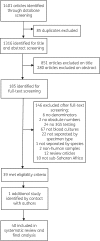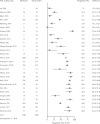Prevalence and outcome of bloodstream infections due to third-generation cephalosporin-resistant Enterobacteriaceae in sub-Saharan Africa: a systematic review
- PMID: 31742611
- PMCID: PMC7021093
- DOI: 10.1093/jac/dkz464
Prevalence and outcome of bloodstream infections due to third-generation cephalosporin-resistant Enterobacteriaceae in sub-Saharan Africa: a systematic review
Abstract
Background: The prevalence of bacterial bloodstream infections (BSIs) in sub-Saharan Africa (sSA) is high and antimicrobial resistance is likely to increase mortality from these infections. Third-generation cephalosporin-resistant (3GC-R) Enterobacteriaceae are of particular concern, given the widespread reliance on ceftriaxone for management of sepsis in Africa.
Objectives: Reviewing studies from sSA, we aimed to describe the prevalence of 3GC resistance in Escherichia coli, Klebsiella and Salmonella BSIs and the in-hospital mortality from 3GC-R BSIs.
Methods: We systematically reviewed studies reporting 3GC susceptibility testing of E. coli, Klebsiella and Salmonella BSI. We searched PubMed and Scopus from January 1990 to September 2019 for primary data reporting 3GC susceptibility testing of Enterobacteriaceae associated with BSI in sSA and studies reporting mortality from 3GC-R BSI. 3GC-R was defined as phenotypic resistance to ceftriaxone, cefotaxime or ceftazidime. Outcomes were reported as median prevalence of 3GC resistance for each pathogen.
Results: We identified 40 articles, including 7 reporting mortality. Median prevalence of 3GC resistance in E. coli was 18.4% (IQR 10.5 to 35.2) from 20 studies and in Klebsiella spp. was 54.4% (IQR 24.3 to 81.2) from 28 studies. Amongst non-typhoidal salmonellae, 3GC resistance was 1.9% (IQR 0 to 6.1) from 12 studies. A pooled mortality estimate was prohibited by heterogeneity.
Conclusions: Levels of 3GC resistance amongst bloodstream Enterobacteriaceae in sSA are high, yet the mortality burden is unknown. The lack of clinical outcome data from drug-resistant infections in Africa represents a major knowledge gap and future work must link laboratory surveillance to clinical data.
© The Author(s) 2019. Published by Oxford University Press on behalf of the British Society for Antimicrobial Chemotherapy.
Figures






References
-
- Laxminarayan R, Matsoso P, Pant S. et al. Access to effective antimicrobials: a worldwide challenge. Lancet 2016; 387: 168–75. - PubMed
-
- Cosgrove SE. The relationship between antimicrobial resistance and patient outcomes: mortality, length of hospital stay, and health care costs. Clin Infect Dis 2006; 42 Suppl 2: S82–9. - PubMed
-
- O’Neill J. Antimicrobial Resistance: Tackling a Crisis for the Health and Wealth of Nations. Review on Antimicrobial Resistance. 2014. https://amr-review.org/sites/default/files/AMR%20Review%20Paper%20-%20Ta....
Publication types
MeSH terms
Substances
Grants and funding
LinkOut - more resources
Full Text Sources
Medical
Research Materials
Miscellaneous

